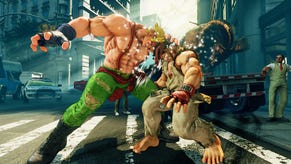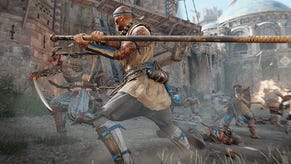For Honor's rough edges hide a diamond worth polishing
Great combat, terrible loot
For Honor is everything Brendan says it is in his review - an often broken and bruising game that assaults your senses with indicators and split second decisions, as well as assaulting your sanity with frequent network issues and inexplicable matchmaking bugs. It's also my favourite game so far this year, thanks to a deliciously layered combat system that draws you in piece by piece while you learn, adapt and try to master the simple yet versatile brawling. Let me explain to you why it's great and why it urgently needs fixing.
For Honor is a collection of influences shaped into something that feels new. It takes a tense Dark Souls duel, fuses it to the factional conflict and gruesome melee of the raucous Chivalry: Medieval Warfare and most importantly and most interestingly, adds a touch of the traditional fighting game into the mix. While most fighting games require a level of manual dexterity beyond what I can hope to achieve with my unwieldy spider hands, For Honor is a game about simple inputs, precision timing and getting inside the head of your enemy.
Perhaps my favourite thing in For Honor is that it's a game you can feel yourself getting better at, simply through play. You'll start out by learning the fundamentals, such as directional blocking and attacks as well as simple combinations and guard-breaks - grappling moves that can be used to punish your opponent with strong attacks, or to toss them towards the plentiful environmental hazards. Next you'll go deeper into the skills and abilities of your warrior of choice, as you learn what makes your class stand out - whether that's the Viking berserker with his or her wildly flailing axes, as you tame them into a brutal symphony of unending aggression, or the measured defence of the Samurai Nobushi with her deadly bleed attacks and terrifying kick chains.
Eventually you'll start to be able to counter your opponent's guard block or grab attempts, recognizing the tight timing window you need to turn the tables, as you embarrass the halberd wielding Lawbringer knight, overcoming his unhealthy obsession with chucking you off a cliff. The better you get at the game and the deeper your knowledge, the more mind-games come into play. Nothing you or your enemy does is infallible, almost everything can be countered and you'll start to recognize patterns of play, working out how to turn a foe's bad habits into an advantage.
Take the Kensai for instance, your basic sword saint Samurai with a terrifying moustached mask, a giant katana and the ability to chain into overhead attacks that are unblockable. The only way to counter such attacks is to dodge away or to parry them by aiming your own heavy attack at a precise moment, leaving the Samurai momentarily staggered. Most decent players will pull off the parry with relative ease, leaving the Kensai in trouble. A slightly more advanced Kensai will use their attack as a feint, pushing you into committing your parry, before attacking you instead from the side. It's a strong, simple maneuver, but if you've played against a few Kensai then you'll expect it and will therefore enter into a battle of wits with the opponent. Maybe they won't cancel the move because they expect you to anticipate the feint. Maybe they'll cancel it twice just to play with you. Perhaps you'll time a dodge to the side and launch into your own offensive.
Those split second decisions, the crunching sound design of the game, the second-guessing and counter-attacking options can turn every duel into a heart pounding moment of unbearable tension as you attempt to out-think and outfight your foe. The cathartic release as you guess correctly, land that final hit and launch into a gruesome execution becomes the satisfying signal to go and grab a coffee, smoke a cigarette or just wait until your heart stops pounding.
Fighting games such as Street Fighter can certainly offer the same thrills, but unless you are truly excellent at them, technical execution of the various moves and combinations is a significant roadblock. For Honor by comparison has a more limited toolset of moves and abilities that lend each contest a focus more on timing, inventive strategy and mind-games rather than being able to bend your fingers into convoluted shapes.
It's pleasing to see that the system is versatile enough to allow for a variety of different styles already. It's perfectly reasonable to launch into every fight using your most basic moves, to probe and test your foe's defences, before taking a step back to consider your options and plan your next attack. Conversely, some players and classes favour reactive play, using solid defence to pick apart their opponent with counters, biding their time before unleashing an arsenal of charges, headbutts, grabs and stabs. Others yet will ignore the community's attempts at imposing basic honour rules on duels, in favour of Brendan's strategy of using the environment to forgo the intricate dance of combat. I myself am not averse to putting a pesky Peacekeeper (a dual-wielding speed-merchant) 'in the bin'.
There are of course issues with For Honor, including some that even go beyond Brendan's concerns. Specifically, it has one of the worst implementations of loot or gear I've ever seen in a game. As you level your character across the various modes, you unlock shiny new armour and weapon pieces that follow a pleasing visual progression from a basic soldier to something a little more unique. That's all well and good, but unfortunately gear also has attached statistics that can boost your chosen warrior’s attack and defense, as well as altering the game’s revenge mechanic.
Revenge mode was introduced late in development, the idea being that if you get into a 1vs2 (or more) situation and are able to stay alive, you’ll eventually get an activatable mode that gives you a health shield, extra damage and interruptible attacks, allowing you to turn the tables on your assailants. Unfortunately, with good gear revenge mode becomes available almost constantly, often even triggering in fair 1v1 situations, giving warriors the ability to kill their foe in one or two hits while they’re shielded from taking damage. Because matchmaking doesn’t take gear into account, you end up far too often with teams draped in finery, pitted against people wearing shoddy jerkins, holding pointy sticks. If you’re looking to test out a new class, you need to be prepared to face off against impossible odds in pretty much every match.
Gear and the fact that matchmaking seemingly doesn't take it into account almost entirely wrecks the carefully created ecosystem of For Honor’s combat. It feels entirely untested and rewards players who either spend real money to pile up loot (you buy gear with the game’s in-game currency, which can either be earned through play, or bought with real money), or stick exclusively with one character. It has forced some players into retreating to the 2v2 and Duel modes where gear is disabled. Gear would be absolutely fine if it simply offered cosmetic changes, but right now it’s deeply unbalanced, overly powerful and makes matches with or against high level opponents simply less enjoyable than those without.
Ubisoft recently acknowledged that gear and revenge mode needs some tweaking in a Twitch livestream, but there is a worry that because it forms a source of income and because players have spent real money getting to the top of the pack, Ubisoft may be unwilling to ring the necessary changes. If Ubisoft want For Honor to live beyond flavour of the month or earn its place in competitive play, they need to consider a serious overhaul - the wonderful combat system deserves far better.














